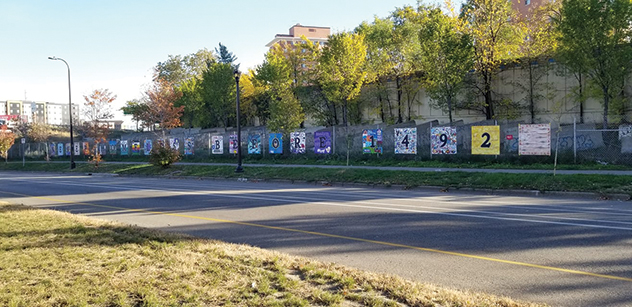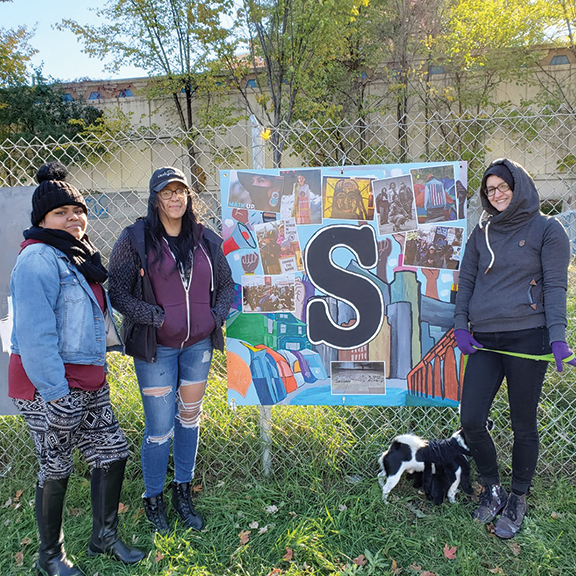
By Lee Egerstrom
Minneapolis city officials cleared an impromptu homeless encampment in early October along East Franklin Avenue on the edge of the American Indian Cultural Corridor. Artwork will now commemorate the former Wall of Forgotten Natives encampment in the same area and raise public awareness of the continuing homeless crisis.
Closing the encampment that cropped up after the 2018 Wall of Forgotten Natives (The Wall) hasn’t ended the homeless problem for Minneapolis, the Native community, or for any other community in America.
It does, however, pose as a temporary fix for health and safety problems for people in the East Franklin and Cedar avenues area impacted by the encampment.
Courtney Cochran, a Minneapolis filmmaker-artist who served as lead artist for the project, said The Wall is being remembered by 23 four-by-four foot corrugated plastic panels that she and other artists and community members created during the past year.
Each panel is centered by a letter that spells out the Indigenous message “Never Homeless Before 1492,” a title chosen by Cochran who is an Anishinaabe artist and art educator originally from Duluth, Minnesota.
Cochran worked with fellow artists Briezy Hart and Josie Hoffman on Oct. 27 to install panels on a temporary fence that has been placed along the Franklin underpass. The installation is expected to remain in place for at least two years.

In the meantime, the Minnesota Department of Transportation (MnDOT) will have crews resurfacing TH Highway 55 (Hiawatha Ave.) and repair bridges on that route, including the bridge over Franklin Ave.
The project is a collaboration among the Native American Community Development Institute (NACDI), its All My Relations Arts gallery, and MnDOT. The groups were planning an official unveiling of the project on Nov. 3, 3 p.m., at the adjacent Minneapolis American Indian Center’s Medicine Wheel Pergola.
Angelina Two Stars (Sisseton Wahpeton Oyate), NACDI’s director of All My Relations Arts, said she reached out and hired Cochran for the project. Much of the work preparing the panels was conducted at the gallery by fellow Native artists and community groups invited to participate.
Most were volunteers, Two Stars said. Many are young artists, friends and students, who have worked with Cochran through the Native Youth Arts Collective.
“Half of the letter panels were designed and painted by different organizations and groups and the rest was made by community members and myself,” Cochran said.
She will also release a short documentary film with stories from residents who resided at The Wall. “I hope the film adds another layer by going further into conversastions around the topic of Indigenous Peoples homeless on their own homelands,” she said.
“I want this installation to also hold space for solutions, joy and healing.”
Cochran said she sees the project as “much bigger than myself as an artist.
“I want to be a good relative and create this in a good way. That to me means helping to create healing spaces and involving the community and our unsheltered relatives as much as possible, before, during and after the fabrication and installation. It’s about building community together and us being able to control our own narrative and voice,” she said.
That message is supported by NACDI and the AMRA gallery’s Two Stars in a news release about the art panels’ installation. “The artwork remembers what happened at the site while also celebrating traditional Native values, lifting up marginalized Native voices, and encouraging dialogue on contemporary issues from a Native perspective that are impacting the ongoing housing crisis in urban Native communities,” the statement said.
That was supported by Jessica Oh, Strategic Partnerships director at MnDOT, who said the project will elevate voices of the unsheltered and support community art making and healing around the American Indian Cultural Corridor.
That could be helpful to the Corridor and broader Minneapolis communities. The impromptu homeless encampment sprang up on the Franklin Ave. median in the past year after The Wall was dismantled. It has been a contentious problem for the area and governmental units.
The encampments have been simultaneously located on MnDOT right of ways, on Hennepin County land, and definitely within the city of Minneapolis. Groups from the neighborhood struggled with finding government units willing to lead roles in trying to find shelters and alternative housing to close the encampment.
The Metropolitan Urban Indian Directors (MUID) was especially active in petitioning for relief citing health and safety problems from violence, sex trafficking, and drug use and sales that followed campers and vulnerable people to the site.
Agreement on how to proceed was accomplished among MUID and groups with the city and country in September. That led to city workers dismantling the camp during the first week of October. Published and broadcast media reports at the time noted that Avivo and the joint St. Stephen’s Human Services and House of Charity organization were among nonprofit housing and shelter groups working with camp residents.
A shooting at the camp site in September caused the nearby Volunteers of America Minnesota (VOAMN) to shift back to virtual, or distance learning, from in-person classes at its Volunteers of America High School. The school is an alternative high school that helps students get back on track for graduation.
The shooting incident and needles and drug paraphernalia left lying around the camp and high school were deemed as a danger to both students and staff.
A week after Minneapolis closed the camp, VOA High School went back to in-class instruction, said Steve Nelson, director of communications.
The Wall of Forgotten Natives brought national attention to Indigenous homelessness in America and especially to Minneapolis. It wasn’t, however, all that unique from what is happening in other urban settings.
While NACDI and Cochran, with help from MnDOT, try to elevate public awareness of people being homeless in their Native homeland, the crisis is far broader across America.
No current information was available at press time on how many of the past encampment’s people may have secured proper housing and shelter with winter fast approaching. And no information was available on how many of the newly displaced will simply move somewhere else to more unsafe living conditions.
Artist Country Cochran doesn’t have an art website but her work can be found on Instagram and on her Facebook page at at https://www.instagram.com/skoden_studio, and at: https://www.facebook.com/courtney.cochran.792.






